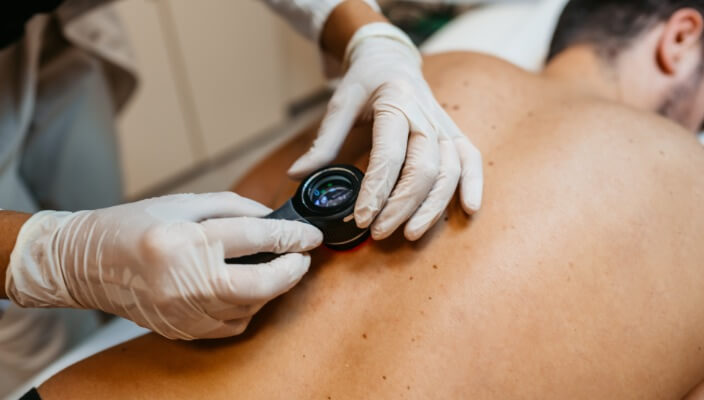Melasma vs. Hyperpigmentation
How to Tell the Difference
 Skin pigmentation varies in each individual, and factors like ethnicity, genetics, and even hormonal changes can influence how our skin reacts to environmental and internal factors. Two common conditions that cause skin discoloration are melasma and hyperpigmentation, and while they may seem similar, understanding their differences is key to receiving the correct diagnosis and treatment. At Keystone Dermatology Partners, our expert dermatologists specialize in identifying and treating both conditions to ensure your skin receives the care it deserves.
Skin pigmentation varies in each individual, and factors like ethnicity, genetics, and even hormonal changes can influence how our skin reacts to environmental and internal factors. Two common conditions that cause skin discoloration are melasma and hyperpigmentation, and while they may seem similar, understanding their differences is key to receiving the correct diagnosis and treatment. At Keystone Dermatology Partners, our expert dermatologists specialize in identifying and treating both conditions to ensure your skin receives the care it deserves.
What is Melasma?
Melasma is a skin condition characterized by dark patches that appear on the skin, typically with a brown or grayish hue. These patches often show up in symmetrical patterns on the face, affecting areas such as the cheeks, forehead, upper lip, chin, and nose. While melasma can affect anyone, it’s more commonly seen in women, especially those with olive or darker skin tones. One of the most significant triggers for melasma is hormonal changes, which is why it's sometimes called the "pregnancy mask" when it affects expectant mothers.
Key characteristics of melasma include:
- Color: Brown or grayish patches.
- Location: It commonly appears on the face, particularly on the cheeks, forehead, and upper lip, but it can also affect other areas like the neck or forearms.
- Triggers: Hormonal fluctuations (such as pregnancy or birth control usage) and sun exposure are common triggers.
Melasma is often linked to increased sensitivity to estrogen and progesterone, which is why women who are pregnant, using hormonal birth control, or undergoing hormone therapy are more likely to develop this condition.
What is Hyperpigmentation?
Hyperpigmentation is a broader term that refers to any skin darkening due to excess production of melanin, the pigment responsible for skin color. Unlike melasma, hyperpigmentation can result from various causes, including skin injuries, acne scars, or prolonged sun exposure. It can occur on any body part and often manifests as brown, black, or even reddish patches.
Key characteristics of hyperpigmentation include:
- Color: Darkened areas may appear brown, black, or red.
- Location: Can develop anywhere on the body, not limited to the face.
- Triggers: Skin inflammation (from acne or injuries), sun exposure, certain medications, and even skin conditions like eczema can trigger hyperpigmentation.
Unlike melasma, which tends to be symmetrical, hyperpigmentation is more likely to appear as scattered or asymmetrical spots on the skin.
How to Tell the Difference: Melasma vs. Hyperpigmentation
While both melasma and hyperpigmentation cause dark spots on the skin, there are some key differences to look for when trying to determine which condition you might be dealing with:
- Color: Melasma usually appears as brown or gray patches, while hyperpigmentation can range from brown and black to reddish spots.
- Symmetry: Melasma often appears symmetrically, usually affecting both sides of the face in the same areas, such as the cheeks or forehead. Conversely, hyperpigmentation is often scattered and may appear in random spots on the body.
- Location: Melasma is more commonly seen on the face and neck, while hyperpigmentation can appear anywhere on the body, even in areas not exposed to the sun, such as the chest or back.
- Triggers: Hormones play a major role in melasma, with pregnancy, birth control, or hormone therapy being common culprits. Hyperpigmentation, however, can be triggered by sun exposure, skin trauma, acne, and even inflammation caused by eczema or psoriasis.
Seeking Treatment: Why You Should Consult a Dermatologist
Both melasma and hyperpigmentation can be frustrating conditions, but the good news is that they are manageable with the right treatment plan. However, determining the exact cause of your skin discoloration is crucial to receiving the most effective treatment.
If you have unexplained dark spots or patches on your skin, consulting with a dermatologist is the best first step. At Keystone Dermatology Partners, our experienced dermatologists will work with you to identify whether you have melasma, hyperpigmentation, or another skin condition. After a thorough evaluation, we’ll develop a personalized treatment plan tailored to your skin’s unique needs.
Common treatments for both conditions include:
- Topical treatments: Prescription creams containing ingredients like hydroquinone, retinoids, or corticosteroids can help lighten dark spots and even skin tone.
- Laser therapy: Certain types of laser treatments can target pigmented areas, reducing the appearance of melasma or hyperpigmentation.
- Chemical peels: These treatments exfoliate the top layer of skin, helping to fade discoloration over time.
At Keystone Dermatology Partners, we are committed to helping you achieve clear, healthy skin. Whether you’re struggling with melasma, hyperpigmentation, or any other skin condition, our team is here to guide you through your treatment options and create a plan that works best for your lifestyle.
Ready to take control of your skin health? Schedule an appointment and start your journey to brighter, more even skin.
Related Blogs

- Skin Cancer
- Sun Safety
When it comes to sunscreen, does a bigger (higher) SPF number mean its better than one with a smaller one? Discover the effectiveness of your sunscreen and what SPF you should be applying.
Read More
- Skin Cancer
- Skin Exams
In this blog, we’re covering what you need to know about five dangerous skin cancers, including basal cell carcinoma (BCC), squamous cell carcinoma (SCC), malignant melanoma, merkel cell carcinoma, and kaposi sarcoma.
Read More
- Skin Cancer
- General Dermatology
- Skin Exams
Navigating the landscape of Total Body Skin Exams: Uncover the comprehensive process, understand why it matters for skin health, and gain insights into what to expect during these essential dermatological examinations.
Read More


